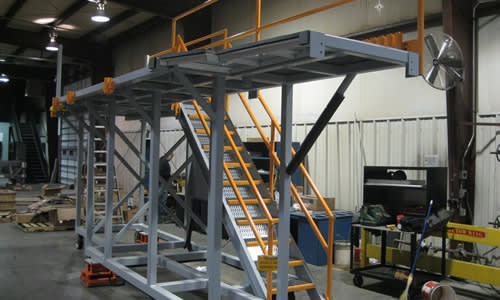Hi, I'm new and fairly lost. I'm trying find wind loads using the ASCE7 trussed tower section on some open framed tooling platforms (similar to attached picture). I'm having trouble deciding how to calculate and apply these loads. I've also been referencing the ANSI/TIA-222 to help clarify some points.
I'm currently thinking I should:
1. consider the 0° and 90° wind directions, calculate solid area based on the projected shape of the entire structure in each direction
2. find the forces associated with those two directions
3. apply either of those forces at some angle (between -90° to 90° relative to the respective face) that provides the worst case for my members and reactions
But I'm unsure of a few things.
1. Should solid area be based on the members within the plane of a face of the tool, and not the all members projected onto that face? The first way seems to be what the ASCE7 is saying, but it feels wrong to ignore surfaces behind the face.
2. ASCE7 says "wind forces shall be applied in the direction resulting in the maximum member forces an reactions." This means I need to consider every angle from 0-360, correct?
3. Can I use the solidity ratio for wind directions normal to a face, and then apply the resulting force at an angle to the same face? Or do I need to be recalculating the solidity ratio (and force) for each angle?

I'm currently thinking I should:
1. consider the 0° and 90° wind directions, calculate solid area based on the projected shape of the entire structure in each direction
2. find the forces associated with those two directions
3. apply either of those forces at some angle (between -90° to 90° relative to the respective face) that provides the worst case for my members and reactions
But I'm unsure of a few things.
1. Should solid area be based on the members within the plane of a face of the tool, and not the all members projected onto that face? The first way seems to be what the ASCE7 is saying, but it feels wrong to ignore surfaces behind the face.
2. ASCE7 says "wind forces shall be applied in the direction resulting in the maximum member forces an reactions." This means I need to consider every angle from 0-360, correct?
3. Can I use the solidity ratio for wind directions normal to a face, and then apply the resulting force at an angle to the same face? Or do I need to be recalculating the solidity ratio (and force) for each angle?

